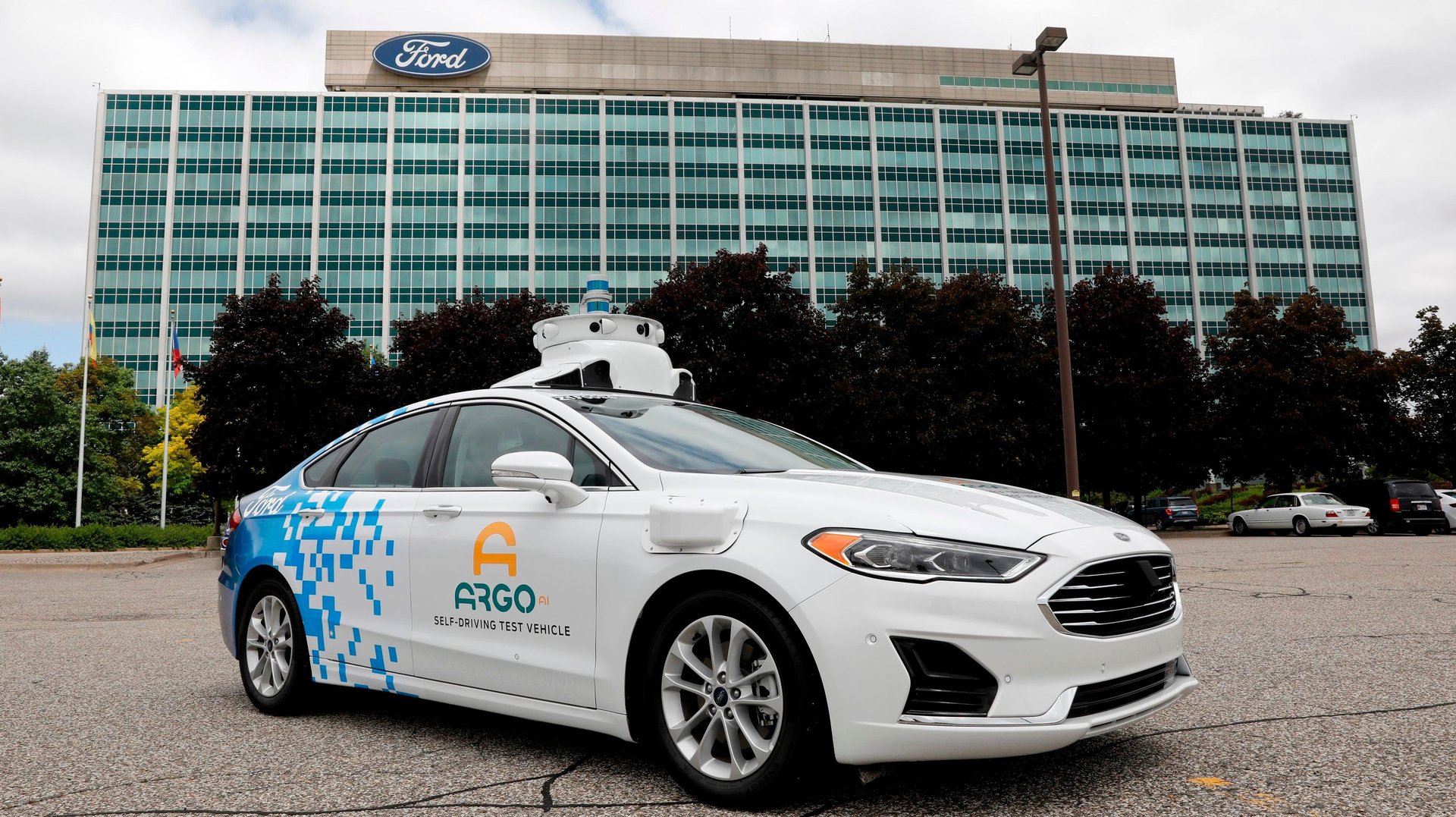Ford and Volkswagen hit reverse gear on self-driving cars
Legacy automakers don’t believe it’s time for driverless vehicles yet

Once a self-driving darling, Argo AI is shutting shop.
When the Pittsburgh firm burst onto the scene in 2017, it drew attention and backing from two massive automakers—US manufacturer Ford and German brand Volkswagen (VW). On the road, it’s charged ahead with tests in US and Germany, as well as driverless cars ferrying its own employees in some American cities. A month ago, Argo AI announced it was partnering with ride-hailing firm Lyft to deploy robotaxis in Austin.
Despite these experiments, Ford said that “the auto industry’s large-scale profitable commercialization of Level 4 advanced driver assistance systems will be further out than originally anticipated,” in its third quarter earnings press release yesterday (Oct. 26). It also added that Argo AI’s tech hasn’t quite found takers, and attracting new investors has been a challenge.
The same day as Ford, Volkswagen also announced it will no longer invest in the company.
Explained: Levels of autonomous driving
Ford’s shifting focus on driverless technology
At a time when 40,000 to 45,000 unfinished vehicles are sitting in Ford’s inventories because of supply chain constraints delaying auto parts availability and “inflation-related supplier costs” running about $1 billion higher than expected, the Michigan-based giant said it “made a strategic decision to shift its capital spending from the L4 advanced driver assistance systems being developed by Argo AI to internally developed L2+/L3 technology.”
In layman terms, the giant is more invested in driving assistance technologies than making cars, cabs, and buses, without human drivers. In fact, CEO Jim Farley even hinted that Ford may outsource the tech even when L4 vehicles are closer to hitting the market, saying that, “we won’t necessarily have to create that technology ourselves.”
Quotable
“It’s estimated that more than $100 billion has been invested in the promise of Level 4 autonomy. And yet no one has defined a profitable business model at scale.” —Ford CEO Jim Farley on the company’s earnings call
By the digits
$1 billion: Ford’s five-year investment commitment to Argo in February 2017, which brought the company out of stealth mode
$2.6 billion: Volkswagen agreed to invest in Argo in June 2020, including $1 billion in cash and $1.6 billion for Argo to take over VW’s European self-driving unit and its 200-plus employees. The deal, which closed in June 2020, made Ford and VW equal shareholders.
$7.5 billion: Argo AI’s valuation in July 2020.
39%: stock owned by Ford and Volkswagen each
2.5%: stock owned by Lyft
$2.7 billion: The non-cash, pretax impairment on Ford’s investment in Argo AI, according to Ford’s earnings for the quarter ended Sept. 30, 2022
$827 million: Ford’s net loss in the quarter ended Sept. 30, 2022
2,000+: Argo AI employees across US and Europe (of which 150 were already laid off in July)
What happens to Argo AI’s employees?
During an all hands meeting yesterday (Oct. 26), some employees were told they may be rehired by Ford and VW, but it’s unclear how many and where. All employees—even the ones who are retained—will receive a severance package that includes insurance, an annual award, and a transaction bonus. Those who are let go entirely will additionally receive termination and severance pay, including health insurance.
Persons of interest: Autonomous vehicle veterans
Argo AI had the makings of a successful driverless car startup, majorly because of the brains behind it. The Pittsburgh-based company’s co-founders have spent the better part of the last decade dedicated to the development of autonomous vehicles
Brian Salesky was fresh out of Google’s self-driving car project when he started Argo AI. Between 2011 and 2016, he was tasked with the development and manufacture of Google’s hardware portfolio, which included self-driving sensors, computers and several vehicle development programs. Salesky also hosts the No Parking Podcast, a show dedicated to building trust in self-driving cars.
Peter Rander spent almost two years as an engineering lead at Uber’s Advanced Technologies Center (ATC), where he “helped launch, grow, and lead several internal ATC teams to reach public launch of Uber’s first-generation self-driving prototypes put on public roads,” his LinkedIn says. Before that, he spent 14 years working on a number of commercialization projects at the National Robotics Engineering Center at Carnegie Mellon University.
A changing roadmap for driverless cars
What Argo is trying to achieve is “what I consider to be the hardest technical problem of our time,” said Doug Field, a former Apple and Tesla engineer who heads advanced tech and embedded systems at Ford now. “It’s harder than putting a man on the moon to create an L4 robotaxi that can operate in a dense urban environment, safely, and navigate to its destination.”
High costs, infrastructural hurdles, and tricky regulations have time and again gotten in the way of players in the industry. While not everyone bites the dust, the sweeping wave of consolidation in the last couple of years is proof of the hardships.
- Uber sold its self-driving unit to Aurora
- Self-driving truck company Ike was bought by delivery robot startup Nuro
- Voyage was bought by Cruise
- Lyft sold its self-driving car division to a subsidiary of Toyota
Several of these companies, which went public with lofty valuations hoping to raise more funding, are seeing their stocks getting battered on the bourses.